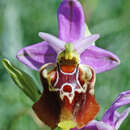Biology
provided by Arkive
This perennial orchid flowers from June to July, after which the visible parts of the plant die, and it survives the summer as an underground tuber (6). The flowers are pollinated by bees, but very few have been observed in Britain and fruit set is usually less than two percent. The tiny seeds are dispersed by the wind in late July and August (6), and require a mycorrhizal fungus to develop (6). Rosette leaves are produced in the autumn and over-winter, withering after flowering (6). It is thought that most plants do not live very long (44 percent for one to three years, and only five percent more than ten years) but some plants may live for up to 30 years (6). It is capable of vegetative reproduction (5), but most reproduction is from seed (6). Some plants have flowered every year for five years, and others remain dormant under the ground for up to four to seven years (6).
Conservation
provided by Arkive
At sites in Wye, east Kent, hand-pollination has been used to try to improve the amount of seed that is set (5). Funding from English Nature has allowed the species to be closely studied at Wye National Nature Reserve (4). All current populations occur within Sites of Special Scientific Interest (SSSIs) (5), and the species is fully protected under Schedule 8 of the Wildlife and Countryside Act, 1981 (5).
Description
provided by Arkive
The rare late spider orchid produces a single upright stem and between two and ten flowers on a spike (2). The pink, purple or sometimes whitish flowers have a broad lip which earns this species its common name due to the similarity of this structure to the body of a spider (2). An area towards the centre of the lip, called the 'speculum' or 'mirror' features a purple or blue pattern in two parallel lines or in the shape of an 'X' or an 'H' (2).
Habitat
provided by Arkive
It occurs on chalk downs and banks, usually on steep south-west to east facing scarps, often on deep, well-drained, calcareous, nutrient-poor soils with very little organic matter (6). It grows in grassland less than 20 centimetres tall, but avoids very open dry places (6).
Range
provided by Arkive
This plant has never been common in Britain; it has only ever been recorded from east Kent and has declined (4). It has been recorded in about 20 sites, of which nine have been seen to be occupied by this orchid since 1990 (5). About 400 to 500 plants are known in Britain (5). In Europe it occurs throughout central southern Europe and reaches east to Asia Minor (4).
Status
provided by Arkive
Nationally Rare and Vulnerable in Great Britain, and fully protected under Schedule 8 of the Wildlife and Countryside Act (1981) (3) and listed on Appendix II of CITES (1).
Threats
provided by Arkive
The main cause of the decline of this species has been changes in agriculture, particularly conversion of grasslands to arable, the decline in grazing, and the use of chemical herbicides and fertilisers. (5). At some sites the late spider orchid is thought to have become extinct due to deep leaf litter and competition with tor grass Brachypodium pinnatum (5). Furthermore, fruit set is very poor, perhaps as a result of a lack of pollinators and poor climate, and reproduction by seed is at best sporadic (6).
Associations
provided by BioImages, the virtual fieldguide, UK
Plant / pollenated
male of Eucera pollenates or fertilises flower of Ophrys fuciflora
Other: major host/prey
Ophrys fuciflora
provided by wikipedia EN
Ophrys holosericea, the late spider orchid, is a species of flowering plant in the family Orchidaceae, native to western and central Europe and the Mediterranean region.[1] There has been considerable confusion about the identity of this species and the correct spelling of its name.[2]
Subtaxa
The following subtaxa are accepted:[1]
-
Ophrys holosericea subsp. andria (P.Delforge) Faurh. – Aegean Islands
-
Ophrys holosericea subsp. apulica (O.Danesch & E.Danesch) Buttler – Eastern and southern Italy, southern Sicily, southern Croatia
-
Ophrys holosericea subsp. biancae (Tod.) Faurh. & H.A.Pedersen – Sicily
-
Ophrys holosericea subsp. candica (E.Nelson ex Soó) Renz & Taubenheim – Italy, Sicily, East Aegean Islands, Greece, Crete, Turkey
-
Ophrys holosericea subsp. chestermanii J.J.Wood – Sardinia
-
Ophrys holosericea nothosubsp. delfuocoi D'Alonzo & Perilli – Italy
-
Ophrys holosericea subsp. elatior (Paulus) H.Baumann & Künkele – Eastern France, Switzerland, southwestern Germany
-
Ophrys holosericea subsp. gracilis (Büel, O.Danesch & E.Danesch) O.Danesch & E.Danesch – Italy, Istria
-
Ophrys holosericea subsp. holosericea – Entire range
-
Ophrys holosericea subsp. lacaitae (Lojac.) W.Rossi – southern Italy, Sicily, Malta, Vis
-
Ophrys holosericea subsp. oblita (Kreutz, Gügel & W.Hahn) ined. – Southern Greece, East Aegean Islands, Turkey, Lebanon/Syria, Israel
-
Ophrys holosericea subsp. oxyrrhynchos (Tod.) H.Sund. – southern Italy, Sicily, Malta
-
Ophrys holosericea subsp. pallidiconi (Faurh.) ined. – South southwest Turkey
-
Ophrys holosericea subsp. parvimaculata (O.Danesch & E.Danesch) O.Danesch & E.Danesch – South-central and southern Italy
-
Ophrys holosericea nothosubsp. robertidarum D'Alonzo & Perilli – Italy
References

- license
- cc-by-sa-3.0
- copyright
- Wikipedia authors and editors
Ophrys fuciflora: Brief Summary
provided by wikipedia EN
Ophrys holosericea, the late spider orchid, is a species of flowering plant in the family Orchidaceae, native to western and central Europe and the Mediterranean region. There has been considerable confusion about the identity of this species and the correct spelling of its name.
- license
- cc-by-sa-3.0
- copyright
- Wikipedia authors and editors

